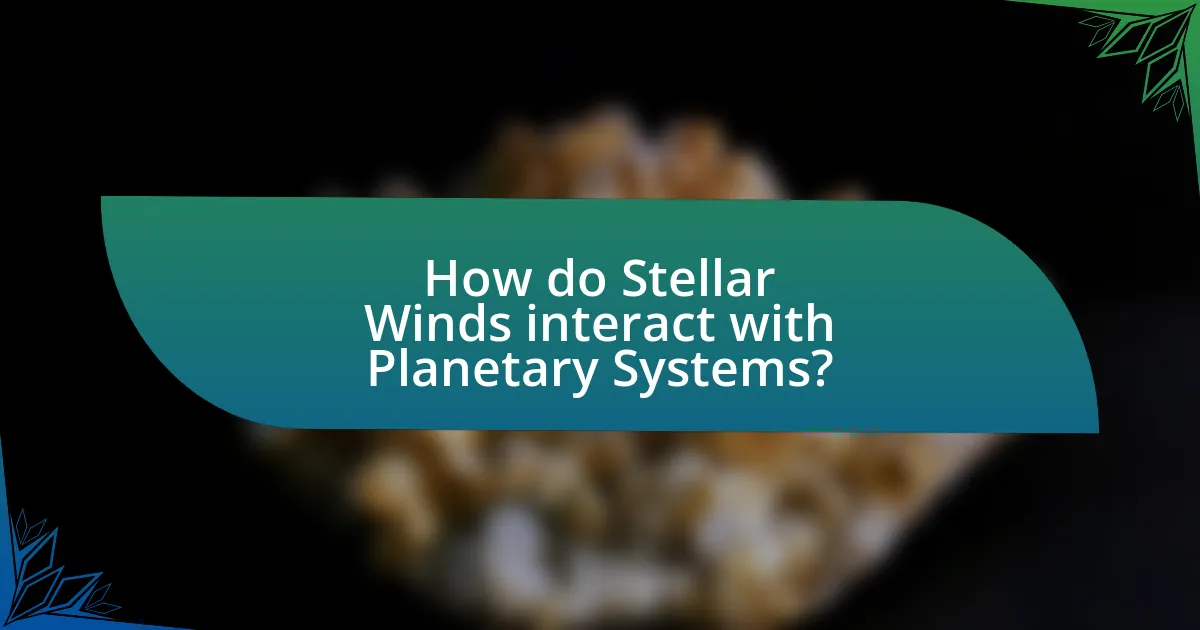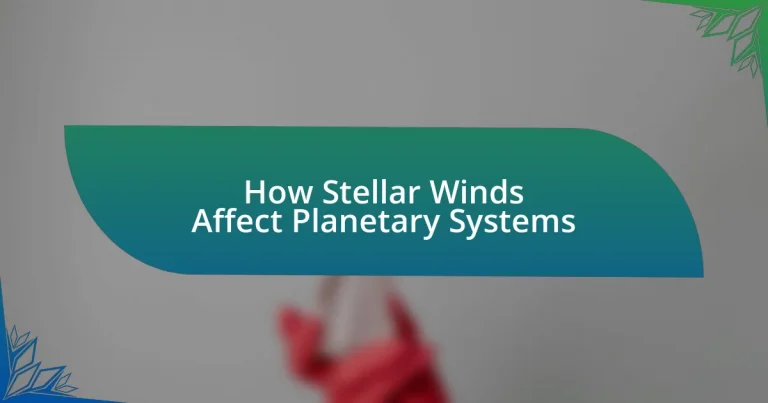Stellar winds are streams of charged particles emitted from stars, particularly during their later evolutionary stages, and play a significant role in shaping planetary systems. This article explores the characteristics of stellar winds, including their formation, types, and the influence of stellar temperatures and mass on their strength. It examines how stellar winds interact with planetary atmospheres, affecting their retention and habitability, as well as their long-term consequences on planetary evolution and orbital dynamics. Additionally, the article discusses the implications of stellar winds for exoplanet research and the techniques used to study their effects on distant planetary systems.

What are Stellar Winds and Their Characteristics?
Stellar winds are streams of charged particles, primarily electrons and protons, ejected from the outer layers of stars, particularly during their later stages of evolution. These winds vary in intensity and composition depending on the star’s mass, age, and temperature; for example, massive stars exhibit stronger winds compared to smaller stars. The characteristics of stellar winds include their speed, which can range from a few kilometers per second to over 3,000 kilometers per second, and their density, which can vary significantly, influencing the surrounding interstellar medium. Stellar winds play a crucial role in shaping planetary systems by contributing to the dispersal of material, affecting star formation, and influencing the atmospheres of orbiting planets.
How do Stellar Winds form?
Stellar winds form as a result of the intense radiation pressure and high temperatures in the outer layers of a star, particularly during the later stages of its life cycle. This radiation exerts a force on charged particles, causing them to be ejected from the star’s surface at high velocities. For example, massive stars, such as O-type and B-type stars, can produce stellar winds with speeds exceeding 2,000 kilometers per second due to their high luminosity and temperature, which can reach tens of thousands of degrees Kelvin. The continuous outflow of these particles contributes to the stellar wind phenomenon, impacting surrounding planetary systems by influencing their atmospheres and potential habitability.
What role do stellar temperatures and pressures play in the formation of Stellar Winds?
Stellar temperatures and pressures are critical in the formation of stellar winds, as they determine the energy and momentum of particles ejected from a star’s surface. High temperatures in a star’s outer layers lead to increased thermal energy, which allows particles to overcome gravitational binding and escape into space. For instance, in massive stars, temperatures can exceed millions of degrees Kelvin, resulting in strong radiation pressure that drives stellar winds at high velocities. Additionally, the pressure gradient between the star’s surface and the surrounding space contributes to the acceleration of these winds. Observations of massive stars, such as those in the Luminous Blue Variable phase, demonstrate that their intense temperatures and pressures produce powerful stellar winds, significantly influencing their surrounding environments and planetary systems.
How does the mass of a star influence the strength of its Stellar Winds?
The mass of a star directly influences the strength of its stellar winds, with more massive stars producing stronger winds. Massive stars, such as O and B types, have higher temperatures and luminosities, which lead to increased radiation pressure that drives the stellar winds more forcefully. For instance, the stellar wind speed can reach up to 3,000 kilometers per second in massive stars, compared to around 100 kilometers per second in lower-mass stars like red dwarfs. This relationship is supported by the theory of stellar evolution, which indicates that the mass-loss rates in massive stars can be several orders of magnitude greater than those in less massive stars, significantly impacting their surrounding environments and the formation of planetary systems.
What are the different types of Stellar Winds?
The different types of stellar winds include solar winds, which are streams of charged particles emitted by stars like the Sun, and massive star winds, which are more powerful outflows from massive stars during their lifetimes. Solar winds typically consist of electrons and protons and can reach speeds of up to 900 kilometers per second, influencing the space weather around planets. In contrast, massive star winds can exceed 2,000 kilometers per second and are significant in shaping the surrounding interstellar medium, contributing to the formation of new stars and planetary systems. These winds play a crucial role in the dynamics of planetary atmospheres and can affect habitability by stripping away atmospheres or delivering essential materials.
How do the characteristics of solar winds differ from those of massive stars?
Solar winds are streams of charged particles released from the upper atmosphere of a star, primarily composed of electrons and protons, while massive stars exhibit stronger stellar winds characterized by higher velocities and greater mass loss rates. Solar winds typically have speeds around 400 kilometers per second and a mass loss rate of approximately 1.5 million tons per year, whereas massive stars can have wind speeds exceeding 2,000 kilometers per second and can lose up to several solar masses per year due to their intense radiation pressure and stellar evolution processes. This difference in characteristics significantly influences the surrounding planetary systems, as the stronger winds from massive stars can strip away atmospheres from nearby planets, while solar winds have a more moderate impact.
What are the implications of varying Stellar Wind types on planetary systems?
Varying types of Stellar Winds significantly impact planetary systems by influencing atmospheric retention, magnetic field strength, and surface conditions. For instance, strong stellar winds can strip away the atmospheres of close-in exoplanets, leading to a loss of water and essential gases, which can render them inhospitable. Research indicates that planets orbiting active stars with intense stellar winds, such as those in the T Tauri phase, experience accelerated atmospheric erosion compared to those around less active stars. This erosion can affect habitability and climate stability, as seen in studies of exoplanets like HD 189733b, where stellar wind interactions have been linked to extreme weather patterns. Thus, the type and intensity of stellar winds play a crucial role in shaping the evolution and viability of planetary systems.

How do Stellar Winds interact with Planetary Systems?
Stellar winds interact with planetary systems by influencing the atmospheres and magnetic fields of planets. These streams of charged particles emitted by stars can strip away atmospheric gases, particularly in planets with weak magnetic fields, leading to atmospheric erosion. For example, Mars, which has a thin atmosphere and lacks a significant magnetic field, has experienced substantial atmospheric loss due to solar wind interactions, as evidenced by data from NASA’s MAVEN mission. Additionally, stellar winds can create shock waves that affect the dynamics of planetary atmospheres and contribute to the formation of auroras, as seen on Earth and other planets with magnetic fields.
What effects do Stellar Winds have on planetary atmospheres?
Stellar winds can strip away planetary atmospheres, particularly those of smaller, less massive planets. This occurs because stellar winds, composed of charged particles emitted by a star, exert pressure on the atmospheres of nearby planets. For example, research indicates that the intense stellar winds from young, active stars can lead to significant atmospheric erosion, as seen in exoplanets like HD 209458b, where observations show a loss of hydrogen from its atmosphere due to stellar wind interactions. Additionally, the strength and composition of stellar winds can influence atmospheric retention, affecting a planet’s potential for habitability.
How can Stellar Winds strip away atmospheres from planets?
Stellar winds can strip away atmospheres from planets through the process of erosion caused by high-velocity charged particles emitted by a star. These winds exert pressure on a planet’s atmosphere, particularly affecting those with weaker magnetic fields or no magnetic protection. For instance, research indicates that planets like Mars, which lacks a significant magnetic field, have experienced substantial atmospheric loss due to solar wind interactions, leading to a thinner atmosphere over time. This phenomenon is supported by data from missions such as NASA’s MAVEN, which has measured the escape of atmospheric particles from Mars, demonstrating the impact of stellar winds on planetary atmospheres.
What factors determine the resilience of a planetary atmosphere against Stellar Winds?
The resilience of a planetary atmosphere against stellar winds is primarily determined by the planet’s magnetic field strength, atmospheric composition, and gravitational pull. A strong magnetic field can deflect charged particles from stellar winds, protecting the atmosphere from erosion. For instance, Earth’s magnetic field effectively shields it from solar wind, maintaining its atmosphere. Additionally, a thicker atmosphere, rich in heavier gases, can better withstand the stripping effects of stellar winds. For example, Venus, despite being closer to the Sun, has a dense atmosphere that offers some protection. Lastly, a planet’s gravitational pull influences its ability to retain atmospheric particles; planets with higher gravity can hold onto their atmospheres more effectively, reducing the impact of stellar winds.
How do Stellar Winds influence planetary formation and evolution?
Stellar winds significantly influence planetary formation and evolution by shaping the environment in which planets develop. These high-velocity streams of charged particles emitted by stars can remove gas and dust from the protoplanetary disk, affecting the availability of material for planet formation. For instance, studies have shown that strong stellar winds can lead to the erosion of the outer layers of protoplanetary disks, which can inhibit the growth of gas giants and alter the distribution of material, thereby impacting the types of planets that form. Additionally, stellar winds can contribute to the heating of the surrounding gas, influencing the thermal conditions necessary for planetesimal formation and the subsequent accretion processes.
What role do Stellar Winds play in the dispersal of protoplanetary disks?
Stellar winds play a crucial role in the dispersal of protoplanetary disks by providing the necessary momentum to remove gas and dust from the disk. These high-velocity outflows, generated by young stars, exert pressure on the surrounding material, leading to the erosion and eventual dispersal of the protoplanetary disk. Studies have shown that the interaction between stellar winds and the disk material can significantly influence the disk’s lifetime and the formation of planets within it, as the winds can clear out regions, allowing for the migration of forming planets and altering their accretion processes.
How can Stellar Winds affect the habitability of planets within a system?
Stellar winds can significantly affect the habitability of planets within a system by stripping away their atmospheres and altering their magnetic fields. When a star emits strong stellar winds, particularly during its active phases, these high-velocity particles can collide with planetary atmospheres, leading to erosion. For example, Mars, which lacks a strong magnetic field, has lost much of its atmosphere due to solar wind interactions, resulting in a cold, inhospitable environment. In contrast, Earth’s magnetic field protects it from such erosion, allowing for a stable atmosphere conducive to life. Studies have shown that planets with weaker magnetic fields or those located closer to their stars are more vulnerable to atmospheric loss from stellar winds, which can ultimately diminish their potential for habitability.

What are the long-term consequences of Stellar Winds on planetary systems?
Stellar winds can significantly impact planetary systems over the long term by stripping away atmospheres and altering planetary climates. For instance, the intense outflow of charged particles from a star can erode the atmospheres of nearby planets, particularly those lacking strong magnetic fields, as evidenced by the loss of Mars’ atmosphere due to solar wind interactions. Additionally, stellar winds can influence the orbital dynamics of planets by exerting pressure on their atmospheres and surfaces, potentially leading to changes in temperature and habitability. Research has shown that planets in close proximity to their stars, such as those in the habitable zone, are particularly vulnerable to these effects, which can ultimately determine their capacity to support life.
How do Stellar Winds contribute to the loss of planetary bodies?
Stellar winds contribute to the loss of planetary bodies by stripping away their atmospheres and, in some cases, causing significant erosion of their surfaces. These high-velocity streams of charged particles, primarily electrons and protons, emanate from stars and can exert pressure on nearby planetary atmospheres. For instance, research has shown that the intense stellar winds from young, massive stars can lead to atmospheric loss in exoplanets, particularly those that are close to their host stars. This phenomenon has been observed in studies of exoplanets like HD 209458b, where the interaction with stellar winds has resulted in a measurable loss of atmospheric material.
What evidence exists of planets being stripped by Stellar Winds in observed systems?
Evidence of planets being stripped by stellar winds is observed in systems such as HD 189733 and WASP-121b. In HD 189733, the planet’s atmosphere is being eroded due to intense stellar winds from its host star, which is a K-dwarf. This was supported by observations from the Hubble Space Telescope, which detected the loss of hydrogen and other elements from the planet’s atmosphere. Similarly, WASP-121b, a hot Jupiter, shows signs of atmospheric stripping as its proximity to a hot star results in extreme temperatures and strong stellar winds, leading to significant atmospheric loss. These findings are corroborated by spectral analysis that reveals the presence of escaping gases, indicating that stellar winds are actively stripping these planets of their atmospheres.
How do Stellar Winds affect the orbital dynamics of planets?
Stellar winds affect the orbital dynamics of planets by exerting pressure on their atmospheres and surfaces, which can lead to changes in their orbits over time. The continuous outflow of charged particles from a star can strip away atmospheric layers of planets, particularly those with weaker magnetic fields, altering their mass and gravitational influence. For example, studies have shown that the loss of atmospheric mass due to stellar winds can result in a gradual inward spiral of a planet’s orbit, as seen in exoplanets close to their host stars. This phenomenon is particularly evident in hot Jupiters, where intense stellar winds can significantly influence their orbital stability and evolution.
What are the implications of Stellar Winds for exoplanet research?
Stellar winds significantly impact exoplanet research by influencing the atmospheric composition and habitability of planets. These high-velocity streams of charged particles can strip away the atmospheres of close-in exoplanets, particularly those orbiting active stars, which affects their potential to support life. For instance, studies have shown that planets within the habitable zone of M-type stars are particularly vulnerable to atmospheric erosion due to intense stellar winds, as evidenced by observations of exoplanets like Proxima Centauri b. This understanding helps researchers assess the viability of exoplanets for hosting life and informs models of planetary atmospheres and climate dynamics.
How can understanding Stellar Winds improve our search for habitable exoplanets?
Understanding stellar winds can significantly enhance our search for habitable exoplanets by providing insights into the atmospheric conditions and potential habitability of these planets. Stellar winds, which are streams of charged particles emitted by stars, can strip away the atmospheres of nearby planets, affecting their ability to support life. For instance, research indicates that strong stellar winds can lead to atmospheric erosion, particularly in planets located within a star’s habitable zone. This erosion can diminish the chances of retaining essential elements like water and carbon dioxide, which are critical for life.
Moreover, by studying the characteristics of stellar winds, such as their intensity and composition, scientists can better assess the habitability of exoplanets. For example, data from missions like the Kepler Space Telescope and the Hubble Space Telescope have shown that planets orbiting stars with weaker stellar winds may have a higher likelihood of maintaining stable atmospheres conducive to life. Thus, understanding stellar winds allows researchers to prioritize exoplanets for further study based on their potential to support life.
What techniques are used to study the effects of Stellar Winds on distant planetary systems?
Techniques used to study the effects of stellar winds on distant planetary systems include observational methods such as spectroscopy, magnetohydrodynamic simulations, and space-based telescopes. Spectroscopy allows scientists to analyze the composition and dynamics of stellar winds by examining the light emitted or absorbed by elements in the wind, providing insights into their interaction with planetary atmospheres. Magnetohydrodynamic simulations model the behavior of stellar winds and their magnetic fields, helping researchers understand how these forces influence planetary environments. Space-based telescopes, like the Hubble Space Telescope, enable direct observation of exoplanets and their host stars, facilitating the study of stellar wind impacts on planetary atmospheres and potential habitability. These techniques collectively enhance our understanding of the complex interactions between stellar winds and planetary systems.
What practical insights can we gain from studying Stellar Winds and their effects on planetary systems?
Studying stellar winds provides practical insights into the atmospheric dynamics and habitability of planetary systems. Stellar winds, which are streams of charged particles emitted by stars, can strip away planetary atmospheres, influencing the potential for life on those planets. For example, research has shown that strong stellar winds from young, active stars can erode the atmospheres of nearby exoplanets, making them less likely to support life. Additionally, understanding stellar winds helps in predicting space weather events that can affect satellite operations and communication on Earth. This knowledge is crucial for developing strategies to protect technology and infrastructure from the adverse effects of solar activity.




